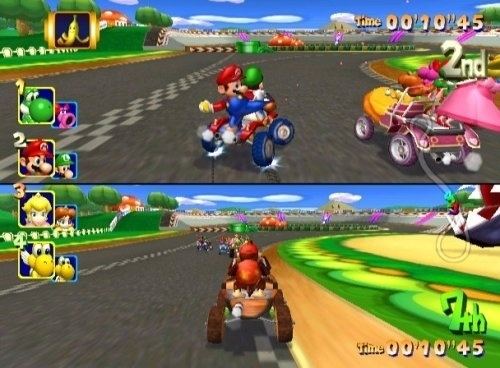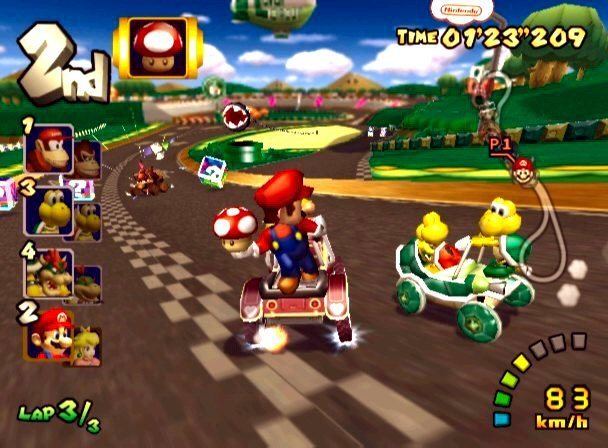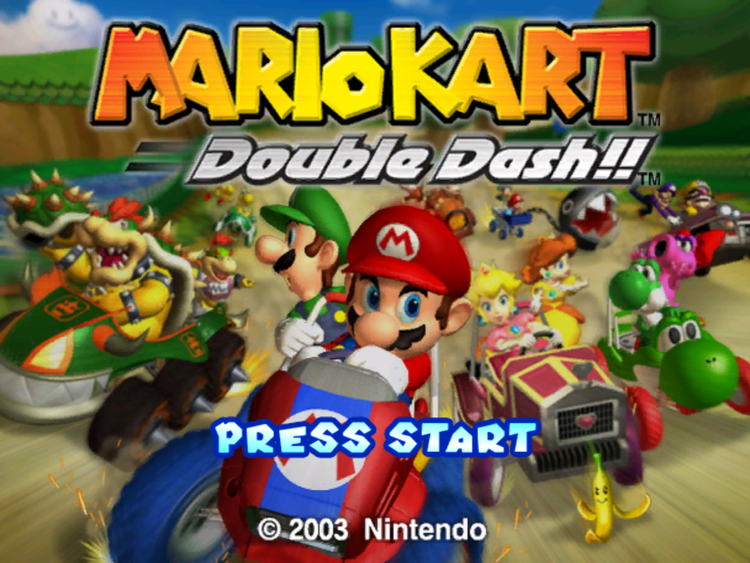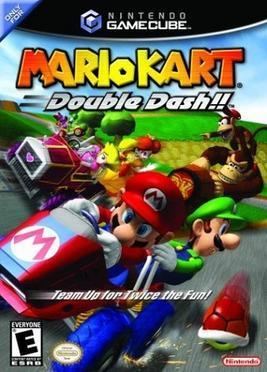8.8 /10 1 Votes
7.9/10 IGN Initial release date 7 November 2003 Publisher Nintendo | 4.5/5 Emuparadise 4.8/5 eBay Genre(s) Racing | |||||||||||||||||||||||||||||||||
 | ||||||||||||||||||||||||||||||||||
Director(s) Yasuyuki OyagiFutoshi ShiraiDaiji Imai Producer(s) Shigeru MiyamotoTadashi SugiyamaShinya TakahashiTakashi Tezuka Composer(s) Shinobu TanakaKenta Nagata Developers Nintendo, Nintendo Entertainment Analysis & Development Similar Mario Kart games, Nintendo games, Racing video games | ||||||||||||||||||||||||||||||||||
Beta64 mario kart double dash
Mario Kart: Double Dash!! (Japanese: マリオカートダブルダッシュ!!, Hepburn: Mario Kāto: Daburu Dasshu!!) is a racing game developed by Nintendo Entertainment Analysis and Development and published by Nintendo for the GameCube in 2003. The game is the fourth installment in the Mario Kart series and the third for home consoles after Mario Kart 64. It was preceded by Mario Kart: Super Circuit from 2001 and was followed by the handheld game Mario Kart DS, which was released for the Nintendo DS in 2005.
Contents
- Beta64 mario kart double dash
- Mario kart double dash gamecube
- Gameplay
- Game modes
- Characters
- Development
- Reception
- References

Similar to previous titles, Double Dash!! challenges Mario series player characters to race against each other on Mario-themed tracks. The game introduced a number of new gameplay features, such as supporting co-op gameplay with two riders per kart. One player drives the kart, and the other uses items. Players can switch at any time. Double Dash!! is the only game in the Mario Kart series to allow cooperative gameplay so far. Double Dash!! supports LAN play using the Nintendo GameCube Broadband Adapter, allowing up to 16 players to compete simultaneously. There are 20 characters to select from in total, each of which with a special item, and with eleven characters being new to the series.

Double Dash!! received positive reviews by critics; it attained an aggregated score of 87 out of 100 on Metacritic. Reviewers praised the graphics and the new gameplay features, but voice acting was poorly received. It was commercially successful, with more than 3.8 million copies sold in the United States, and more than 802,000 copies sold in Japan.

Mario kart double dash gamecube
Gameplay

Double Dash is a kart racing video game in which the player races in a kart against other teams in different courses. The game screen indicates the current standings in a race, the current speed of the player's kart and incoming weapons. Like in the previous installments, players can pick up item boxes to receive a randomly selected item and use it to impede the opposition and gain the advantage. Some items, such as shells and bananas, allow the player to hit others to slow them down, while other items, such as the star power-up, render them temporarily invincible to attacks. This is the only game in the series in which instead of one character per kart, there are two: one to drive, and one to use items; and is also the first in the series where players drop their items when hit by a weapon. The powerslide technique, an action that allows the player to drift around turns, has been improved; players can tilt the control stick while drifting to make sparks appear around their kart. If tilted enough, the sparks turn blue, and the player gains a speed boost known as a "mini-turbo". The rocket start, an action that allows the player to gain a speed boost when a race begins is also improved as the Double Dash, which can only be done as a team.
Game modes

There are four game modes in Double Dash: Grand Prix, Time Trial, Versus, and Battle. Most of the modes can be played cooperatively, while some can only be played by themselves in single-player races.

Characters
Players can choose from a cast of 20 playable drivers divided in 10 pairs. All of the characters have their own special items which are unique to them, like Mario and Luigi with Fireballs, Donkey Kong and Diddy Kong with Giant Bananas, Bowser and Bowser Jr. with Bowser Shells, Yoshi and Birdo with Eggs, Peach and Daisy with Hearts, Wario and Waluigi with Bob-ombs, Koopa Troopa (who previously appeared in Super Mario Kart) and Paratroopa with Triple Shells, Toad and Toadette with Golden Mushrooms, and Baby Mario and Baby Luigi with Chain Chomps. Petey Piranha and King Boo have the unique ability to use any of the other characters' special items excluding Luigi's Green Fireball and Birdo's Pink Egg. There are 21 karts in all and the character's weight class (light, middle, or heavy) determines the kart in which they can ride as well as their speed, acceleration, and weight attributes.
In addition, other characters have supporting roles in this game as well. Lakitu reprises his role as the referee, helping racers in various situations such as announcing laps, giving the signal to drive with its traffic lights hanging on a fishing pole, and taking characters back on track in case they fall off course. Other supporting characters appearing in this game include Shy Guys, Goombas, Nokis, Toadsworth, Piantas, Chain Chomps, Piranha Plants and more. It should also be noted that this is the very first time that Toadette has appeared in the Mario franchise.
Development
Double Dash was first shown at E3 2001 as a seven-second video clip. The clip featured Mario and Luigi driving their karts on a bump mapped 3D surface with no background. At the time, it was early in development, and the working title of the game was simply Mario Kart. In April 2003, Nintendo released the first pictures and details of the game, as well as revealing the title to be Mario Kart: Double Dash!!. At E3 2003, a playable demo of the game was available. New features, such as having two characters drive one kart, had been implemented. An updated demo with some new additions was shown at the Games Convention in August 2003. In September, Nintendo held a Gamers' Summit for the press, in which a nearly complete and more sped up version of Double Dash was displayed. The Gamers' Summit also announced the North American release date to be November 17, 2003.
The development team struggled in devising gameplay features that would be enjoyed by the fans of the series. One of the hardest tasks chief director Kiyoshi Mizuki was assigned to do was to attract people who had no prior experience with the series; he decided to make the gameplay as simple as possible. Producer Shigeru Miyamoto presented the staff with a variety of opinions which they in turn would have to incorporate into the game the best way possible. Miyamoto let the team decide which graphics they wanted to use without restrictions.
Connectivity to the Game Boy Advance was discussed as an opportunity among the developers, but they eventually agreed that Double Dash!! was not suited to these connectivity ideas and decided to exclude it. It was desirable to narrow down the gap between the ability of veteran and novice players. Therefore, gameplay features like the ability to escape the banana were removed; the staff wanted both veteran and novice players to enjoy themselves.
A special edition of the game was also released, which included a bonus disc containing demos and gameplay videos of other games released around the time, including Mario Party 5, Disney's Hide and Sneak, F-Zero GX, Pokémon Colosseum, Pokémon Channel, Sonic Heroes and Kirby Air Ride, among others. The special edition disc also includes exclusive digital content that could be transferred to the Game Boy Advance title Fire Emblem via the Game Link Cable.
The game's soundtrack was composed by Super Mario Sunshine composer Shinobu Tanaka and Mario Kart 64 composer Kenta Nagata.
Reception
Double Dash received positive reviews. The game received the "Multiplayer Game" award from ITV's Game Stars in 2004. The game sold 3.8 million units in the United States, and over 802,000 units in Japan. According to the NPD Group, Double Dash!! was the best-selling game of November 2003. It is also the third best-selling GameCube game in Australia. Joystiq reported in February 2009 that the game had sold nearly seven million copies worldwide. The game placed 63rd in Official Nintendo Magazine's 100 greatest Nintendo games of all time.
Nintendo Power gave the game a perfect score, and said the graphics were of "3-D perfection" and the controls and game mechanics "rival those of any GCN racing game". Double Dash also received a perfect score from GamePro, who commented that the gameplay remains "fast and furious". The feature of having two riders per kart was praised by Justin Leeper and Andy McNamara of Game Informer; McNamara stated: "Giving the player control of two different characters is pretty cool in single-player, but add a friend on the back of your kart in multiplayer and it opens the game up like never before." GameSpy called Double Dash!! a "great-looking, great-playing game that most gamers will instantly warm to." Eurogamer thought the game was one of the "finest pieces of electronic entertainment ever developed." GameZone's Louis Bedigian felt that none of the racing games he had played for the GameCube were as "spectacular" as Double Dash!!. GMR's Andrew Pfister said, "Mario Kart: Double Dash is the most fun you'll have with a game this year. And probably next year. And maybe even the year after that". Brett Elston of GamesRadar praised the game's "dual-riders idea and untouchable multiplayer". Electronic Gaming Monthly said that the game's "pure, exhilarating glee will envelop your soul".
Double Dash has also received criticism from the media. Considering the 7-year gap since Mario Kart 64, GameSpot's Ryan Davis stated that he was "a little disappointed with the limited scope of the game". He also said that the repetition of the voice acting was "unrelenting". IGN was also critical towards Double Dash for not progressing beyond its predecessor, calling the game a "mediocre effort". The UK-based publication Edge accused the game of "not being a racing game anymore." Game Revolution criticized the game's single-player mode for lacking substance and the track design for being "bland".
